- Expert advice/
- Invites & paper/
- Invitations/
- What Information Should Be Included on Wedding Invitations & Invitation Suites?
- Invitations
What Information Should Be Included on Wedding Invitations & Invitation Suites?
Wondering how to convey all the information needed for your wedding in a stylish and elegant way? The wedding invitation suite is the perfect option.
Last updated July 1, 2025
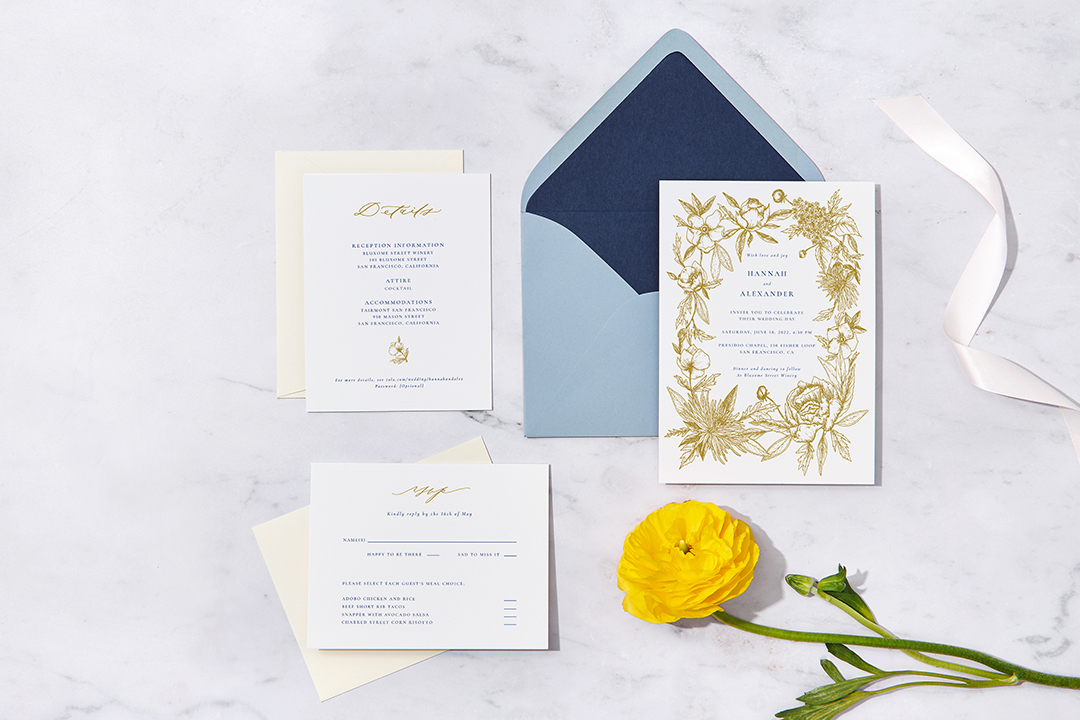
Shop invitations
View allWedding invitations are the beautiful pieces of paper that you get in the mail when a loved one is getting married. This essential stationery is typically pretty straightforward—it tells you the date, time, and location of the ceremony. But, most weddings have a lot more going on than just the ceremony itself.
From the reception dinner to the farewell brunch, a wedding weekend is often packed with activities in various places. So, how does one convey all this extra information in an equally stylish and elegant way? With a wedding invitation suite, of course.
Your wedding invitation is your guests' first glimpse into your special day. At Zola, we understand the importance of making this first impression count. Our comprehensive guide helps you navigate everything from essential information to design elements, ensuring your invitations perfectly represent your celebration.
Here's what you need to know about wedding invitation essentials and how a Zola invitation suite can help you start off with a bang. P.S. We even included tips for including accessible wedding information so all of your guests can be in the know.
Essential Information for Wedding Invitations
Your invitation will set the tone for your wedding while telling your guests all of the essentials. But what are your must-haves? Here's the scoop on invitation wording:
Required Information for Wedding Invitations
If you're short on space, it's ok to communicate just a few things to your guests. Here are things to always put on a wedding invite:
- Host names
- Names of the couple
- Wedding date and time
- Location, including address
Optional Information for Wedding Invitations
While the following isn't 100% necessary, adding these bits to your invitation will help field a lot of questions:
- Dress code
- Wedding registry information
- Wedding website address
Wording Etiquette and Guidelines
Determining the formality of your wedding will help you decide whether your event needs a formal invitation vs. a casual invitation. Also, keep in mind any religious considerations or traditions that you, your partner, or your families wish to uphold.
Wedding Invitation Wording Samples
In addition to etiquette guidelines, the expert team at Zola has curated a list of wedding invitation wording samples to inspire your special day.
Traditional
Traditional wording borders on formal wording conventions and having abbreviations to avoid, for example: Mr. & Mrs. Allen Argyle request the pleasure of your company at the marriage of their daughter Summer Leigh Argyle to Aiden Jack Winter, Friday, the Seventeenth of June, two thousand and twenty seven at half past six in the evening at Loveland Chapel, 400 S Marry Way, Jonestown, Alabama. Reception to follow.
Modern
Modern wording has freedom to be more casual, such as: With joy, Hailey Mueller and David Wu invite you to celebrate their marriage Saturday, September 14, 2028 at 4 o'clock in the afternoon, The Willow Creek Barn, Napa, California. Reception to follow. Please RSVP by August 15, 2028.
Funny
Add cheekiness with a fun, casual invitation, like this: After years of swiping right (and a few lefts we’d rather forget), we’ve finally decided to make it official. Join us for a day of love, laughter, and maybe a little bit of chaos, as we embark on this grand adventure of marriage! Thursday, October 31, 2029 at 8:30 p.m. until the party's over. Don't forget to RSVP on our website so we can save you a drink.
Couple-hosted
Hosting your own affair? Feel free to put your names front and center as such: Chance Carter and Derek Chaus invite you to celebrate their marriage on Saturday, June 12, 2027 at Opal Christian Church, Swethville, Colorado. Dinner and dancing to follow.
Religious
With hearts full of joy and gratitude for God's blessings, Mr. and Mrs. Charles Dykstra request the honor of your presence at the marriage of their daughter, Kaila June Dykstra to Brendan Forrest Lewis, son of Mr. and Mrs. Matthew Lewis, Sunday, the Eighth of July, two thousand and twenty six at five in the evening at Contemporary Museum of Art, 1702 Canvas Way, Schweizville, Texas. Reception to follow.

A Complete Guide to Wedding Invitation Suites
What Is a Wedding Invitation Suite?
In short, a wedding invitation suite is a set of matching enclosure cards with the purpose of communicating extra information that may not fit on (or be proper to add to) the invitation itself. These cards may also come with a separate envelope and decorative elements, such as a sticker or ribbon.
An invitation ensemble is designed to go above and beyond the basics and truly prepare guests for the events to come.
What Does a Wedding Invitation Suite Look Like?
Most invitation suites are made up of several matching cards, various envelopes, and any other decorative elements you choose to include.
Your main invitation and your invitation suite components are also a chance to get creative. Couples can make a variety of decisions when putting this together, such as:
- Choosing a color scheme
- Adding ribbons
- Including colorful envelopes
- Using a wax seal
- Incorporating lace details
If you’re a couple who takes pride in the stylistic elements of your big day, then putting together a wedding invitation suite may be the way to go. Finding the perfect one is easy when you use Zola. Choose from hundreds of stylish wedding invitations, along with matching enclosure cards to fit all the necessary information.
What’s Included in a Wedding Invitation Suite?
Every couple’s invitation suite will look a little different. Not only does personal style have an effect on the invitation suite, but the events related to your actual wedding will also determine what’s included.
There are key elements people traditionally include. Let’s take a look wedding suite components along with a few unique options that might pique your interest.
NOTE: Please don't feel as though you need to have separate cards for all of the following, as these are just the general types.
Direction Card
While many people may scoff at the idea of physical directions (given the blessing of modern GPS technology) there are several reasons why a direction card or insert is helpful for guests: (hint: you can even include a custom map)
-
Rural weddings – From lost cell service to unmarked roads, you never know what a rural, beachside, or mountain top wedding venue may throw at you.
-
Traffic – Couples can list alternative routes, rush hour times, and streets to avoid in order to help their guests beat the local traffic and get to the ceremony like a true local.
-
Different directions – It may be courteous to write out separate directions for guests depending on which neck of the woods they’re coming from.
Reception Card
Many couples opt for a separate reception location, which is particularly common for ceremonies at religious, small, or outdoor spaces. A wedding invitation typically lists the ceremony time and location, with no reception information, other than maybe a line that says “reception to follow.”
A reception card can help clarify and should have the following information listed on the front, in simple, straightforward language:
- Date
- Timeline information (reception start, dinner time)
- Venue name and address
- Activities, such as dinner, drinks, appetizers, dancing, etc.
Transportation Card
You probably don’t want guests transporting themselves from the ceremony to the reception, if you can avoid it. By keeping everyone together, you’ll ensure a more seamless transition from one portion of the night to the other.
Guests may also need help getting from the reception venue to their hotel accommodations—especially with an open bar. Whether you’re providing limo services, a shuttle, or ride-sharing options, list the details and timeline of any and all transportation on this card.
Attire Card
One of the most frequently asked questions is, "What do I wear?" And that's where an attire card can provide direction. On it you’ll specify which of the following dress codes are required for the ceremony and reception:
-
Black tie – Formal gowns and tuxedos are expected.
-
Cocktail – Dresses may be shorter in length, while maintaining a fairly formal look.
-
Semi-formal – Typically includes long, but simple dresses paired with suits.
-
Casual – Opt for lightweight maxi dresses, button-up shirts, and slacks.
Response/RSVP Card
One of the most important parts of your wedding invitation suite will be the response card. On the response card, your guests will fill out the main sections:
- Whether they will or will not be attending the wedding
- Which entree choice they would prefer
You can also include a line for plus ones or invited children. Another option is to still have a card, but direct guests to your wedding website to RSVP.
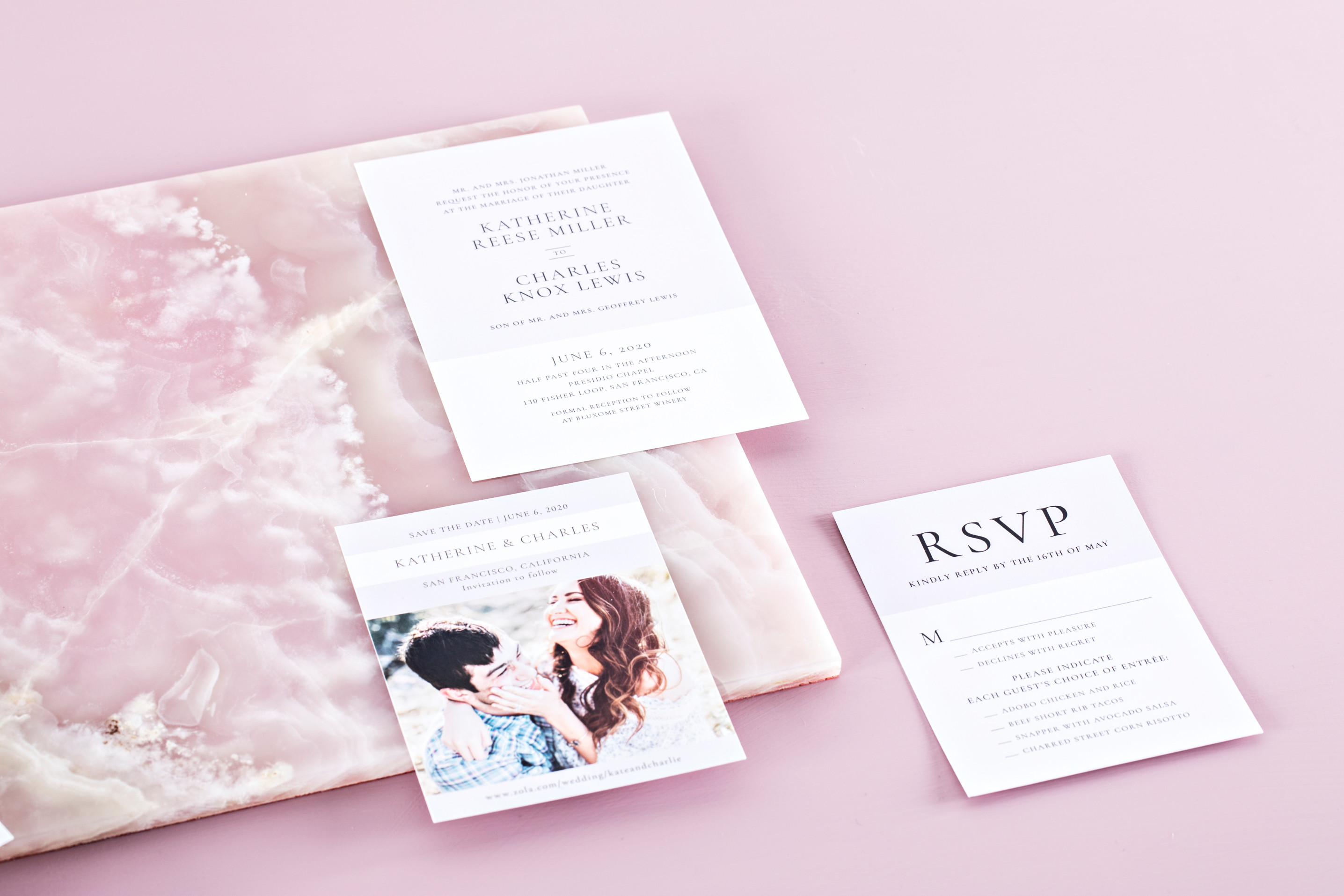
Wedding Website Card
If you’ve put the time and effort into crafting a beautiful wedding website, you’ll want to make sure that guests can access it. Simply add your URL and any passwords necessary to a card, and include this among the other stationery in your invitation suite. Free free to put additional information, such as your wedding registry details.
Accommodation Card
Whether you’re paying for a hotel room, reserving a room block, or recommending nearby facilities—add an accommodation card. You can also list accommodation information on your wedding website and have clickable links.
Itinerary Card
If you're hosting other events, incorporate an itinerary card in your invitation suite. Examples of items that may be listed on an itinerary card include:
- Rehearsal dinner
- Welcome celebration
- Ceremony
- Cocktail hour
- Reception
- Farewell lunch, brunch, or dinner
Also list the time, date, and location of event event along with expected attire for cohesive wedding stationery.
Accessibility Card
Have guests that have mobility, hearing, or sensitivity issues? Add a card in your wedding stationery suite letting guests know what (if any) accommodations you will be making. Whether you have an ADA-compliant venue, are hiring an ASL interpreter, or are having fireworks, letting sensitive guests know ahead of time via a card is extremely thoughtful.
When Should I Send Out My Wedding Invitation Suite?
Similar to individual invitations, send out your invitation package around six to eight weeks before the wedding date. For destination weddings, mail invitations a bit earlier (Zola recommends 10-12 weeks or more).
Order wedding invitations and enclosure cards well in advance, in order to avoid delays or shipping issues. Six months before the wedding is typically the ideal time to place your stationery order.
How to Design Your Wedding Invitation Suite
Putting together the packet of information for your guests is one of the most creative parts of wedding planning. Couples can incorporate their unique wedding style into the decor of their suite. Here are a few ideas and points of wedding invitation etiquette.
Match your wedding color palette.
By sticking with the same color palette and design, you can give guests a sneak peek of what’s to come on the wedding day. Select invitations that coordinate with your overall wedding theme. Below are some of the ways color can be incorporated into your invitation suite:
- Outer and inner envelopes
- Stamp
- Ribbon
- Wax seal
- Dried flowers or botanical elements
Add creative decorative elements.
Try out these fun, stylish ideas for wedding invitations that truly stand out from the crowd:
-
Return envelope and postage – If you’ve included a physical response card in your invitation suite, it’s important to insert a return envelope and postage, too. Some couples take this a step further and order custom stamps with their names, photos, or wedding art.
-
Custom photo – If you’ve had any engagement or wedding portraits taken recently, now is the perfect time to show them off.
-
Belly band – Instead of a simple ribbon tying the cards together, a belly band (often printed with a monogram or names) is a thicker strip of fabric that keeps everything in line.
-
Foil – Gold, silver, or rose gold foil outlines add just the right amount of shimmer to typography and borders.
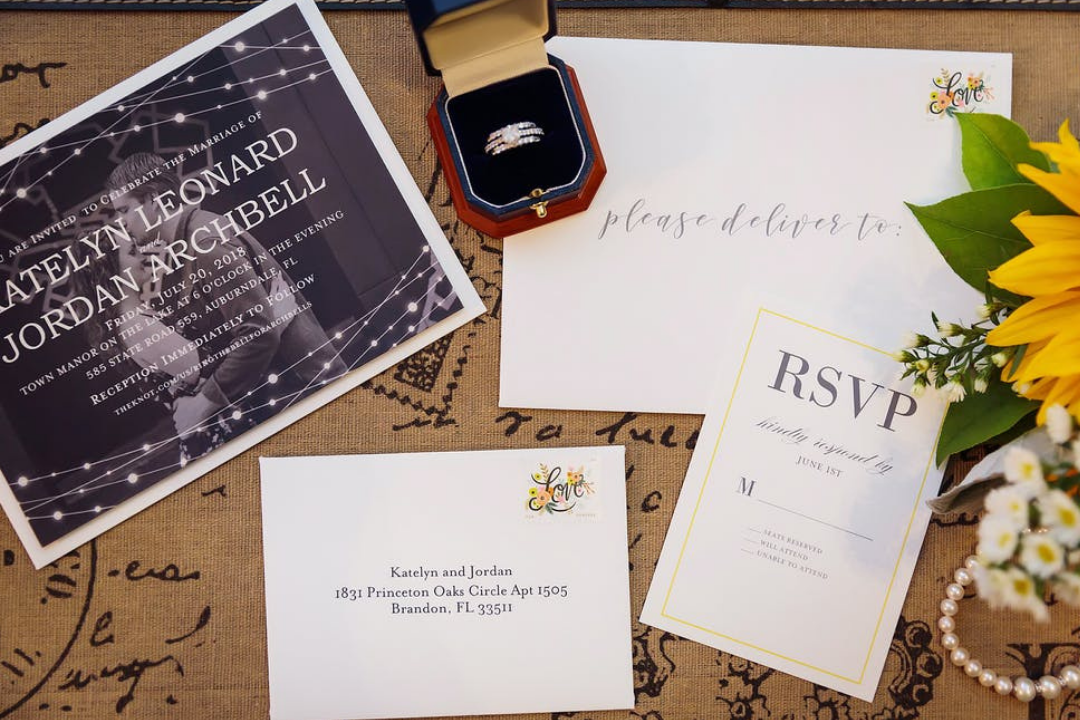
Include assessibility information on your invitation suite.
Although many couples don't think about it, being conscious of disabled guests is very thoughtful. In fact, one in four Americans has some sort of disability. Adding information to your invitation suite (or at the very least, your website), can help you have a disability-friendly wedding. Here are a few types to consider for accessible wedding invitations:
- Mobility considerations - Folks who have terrain issues or need wheelchair access will need to know they'll be able to get around easily. Looking at ADA-compliant venues is also helpful.
- Sensory considerations - Some are sensitive to various noise levels, bright or strobe lighting, or overpowering scents.
- Dietary considerations - Food can cause all sorts of allergic reactions for some. Therefore talk to your caterer about having dairy-free, gluten-free, nut-free, vegetarian, and vegan options on your menu.
- Communication considerations - If some of your guests are deaf or hard of hearing, consider hiring an ASL interpreter or having assisted listening devices.
So, where should you put this accessible venue information? Placement will depend on the type of need. However, you should always put accessibility information on your wedding website. Here are a few examples for your inclusive wedding planning invitation wording:
- For mobility accommodations: - This information can be put on separate detail cards, but you can also put it on your wedding invitation. Example: Our venue is wheelchair-accessible with ramps at each entrance.
- For sensory considerations - Sensory issues can also be addressed with a card or line on your invitation. Examples: Please be advised that our reception has dim lighting, but we will provide extra illumination for low-light-sensitive guests. or We are committed to having a fragrance-free event for our scent-sensitive attendees.
- For dietary restrictions - The RSVP card is an ideal place for you to add meal information. In addition to traditional chicken and beef selections (or whatever you choose), add options for vegan, gluten-free, and other considerations. You can also allow guests to write in any ultra-specific dietary restrictions, such as an allergy to peppers.
- For communication issues - Alert hearing-impaired or hard-of-hearing guests that you'll have a special section for them on a separate card or invitation. Example: Hearing impaired guests are invited to sit up front in our special section with an ASL interpreter and listening devices so they don't miss a moment of our vows.
- If you're uncertain if there are issues - Put an ask on detail cards or the wedding invitation, stating that you'd like to made accommodations for disabled guests. Example: For any accessibility needs or questions, please contact us via (add either email or phone). Also, visit our wedding website at (insert web address) for complete accessibility details.
5 Tips: What Zola Experts Recommend
1. Use digital integration.
The traditional wedding invitation format involves mailing a paper invitation and having the guest mail back an RSVP card—you can still totally do that! However, there are modern invitation alternatives, such as digital save-the-dates and online RSVPs. As a couple, you can use your Zola wedding website for RSVP management and track dietary restrictions, seating preferences, and lists for separate wedding-related events.
2. Plan an invitation budget.
One easy way to save on invitations is to order them early enough so that you don't have to pay for rush shipping, which can cause extra stress. Wedding invitation wording is simple with Zola templates, where you just fill in the blank. Additionally, extras like letterpress, foil, and triple-thick cards come at an extra cost (but can be totally worth it!).
3. Track your timeline.
The recommended timeframe for ordering your Zola invitations is 6-8 months prior to your wedding (which is really helpful if you've made a mistake or need to make a change). However, there are rush options if you find yourself needing them two weeks beforehand. You should mail out your invitations 6-8 weeks (10-12 weeks for a destination event) ahead of time and request RSVPs 3-4 weeks before your caterer needs a head count.
4. Choose sustainable options.
Having an eco-friendly wedding can turn a potentially wasteful day into one that has the environment top of mind. The same goes for your wedding stationery suite. While many will save your invitation as a keepsake, you could also go digital where you can, such as save-the-dates and RSVPs.
5. Nod to your background.
Some cultures and religions have their own traditions. Christian weddings tend to utilize Bible verses. Indian invitation wording typically focuses on family and multiple events, rather than the brief, couple-centric invitations most are used to. Channel your family background and religious beliefs to further personalize your wedding invitations.

FAQ About Invitation Wording
Do I need to include both parents' names?
If your parents are both paying for the wedding, it's appropriate to add their names to the host line of your invitation. If you and/or your partner are paying for the wedding, you can still choose to add your parents' names to the invitation as a courtesy, but it's not a must if they're not the true host.
How should I word the invitation if my parents are divorced?
When your parents are not together anymore, list them separately on the invitation. Whether or not you include their partners, is up to you, your relationship with them, and if they're involved in paying for your special day.
Should I spell out dates and names or use numerals?
If you are planning a formal event, spell out any numbers in your wedding invitations. For a more casual event, it's acceptable to use numbers.
How should I indicate plus-ones on the invitation?
Because your invitations will be mass-printed and go out to everyone, handle plus-ones on the RSVP card and the addressing of the invitation. If your invitation wording includes a plus-one, you'll open the door for everyone to bring one.
What's the proper way to request an RSVP?
When folks are RSVPing on your website, you can put the RSVP information on your wedding invitation. However, traditionally, wedding invitations include a separate RSVP card to be mailed back (therefore, including a pre-stamped, addressed envelope). You can add one of the phrases below along with your RSVP deadline.
- Kindly reply by (date)
- Your response is requested by (date)
- Please respond by (date)
What's the difference between a host line, request line, and ceremony line on invitations?
The host line lists who is hosting the wedding, which is often followed by the request line—verbiage about requesting the honor of the guest's presence. The ceremony line can often be more than one actual line, but it's purpose is to list the details of the ceremony, such as date, time, name of venue, and address. Ceremony details are typically listed separately from reception details in the sequence of events on invitations.
Craft Your Dream Invitation Suite at Zola
Zola is here to help, no matter the nuptial necessity. We’re a one-stop shop for all things wedding—from eye-catching wedding invitations to matching enclosure cards, and even stunning save-the-dates with customizable features.
The perks of using Zola don’t stop at the custom invitation suite, either. Couples can also utilize our pre-screened wedding vendors to find wedding venues, DJs, caterers, and more. Additionally, we also offer expert wedding advice to help you plan your perfect day every step of the way.
Putting together a wedding takes work, but it doesn’t have to be stressful. Shorten your to-do list and start planning your big day the modern way at Zola.
Shop invitations
View allUp next for you
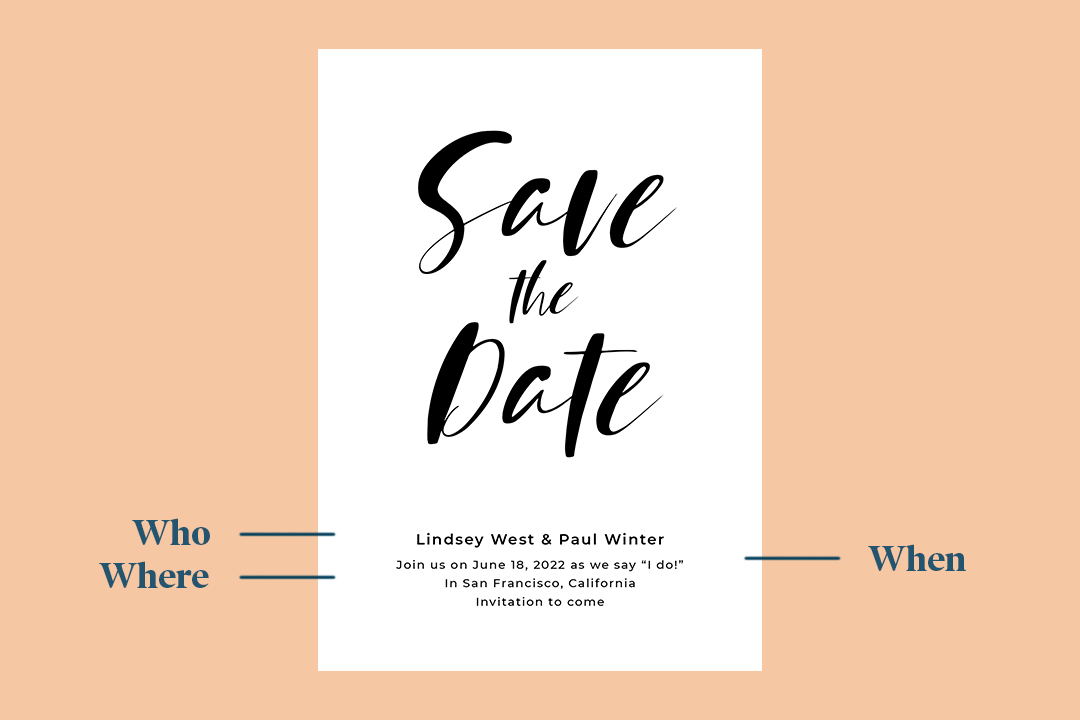
A Guide to Save The Dates
Inspiration
Save the dates add an extra touch of style and coordination to your wedding. Find out why and when you should send your save the dates with this complete guide.
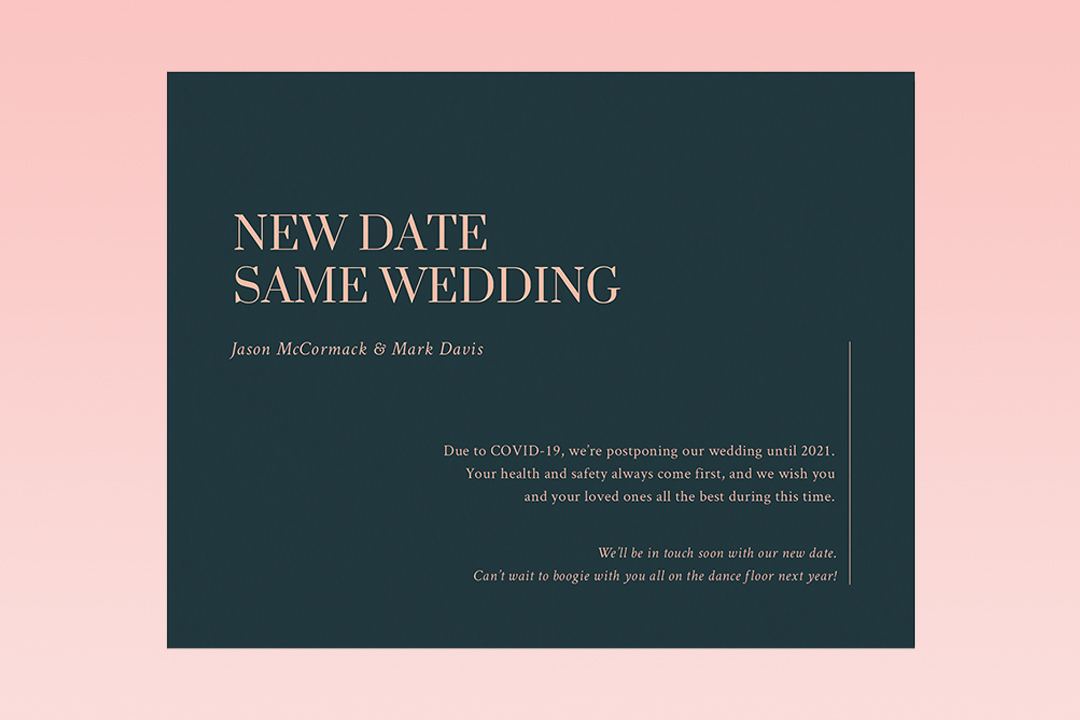
How to Update Guests About Changes to Your Wedding
How-To
If you need to postpone, cancel, or otherwise change your wedding details, we're here to help with our guide to updating your wedding guests about changes.
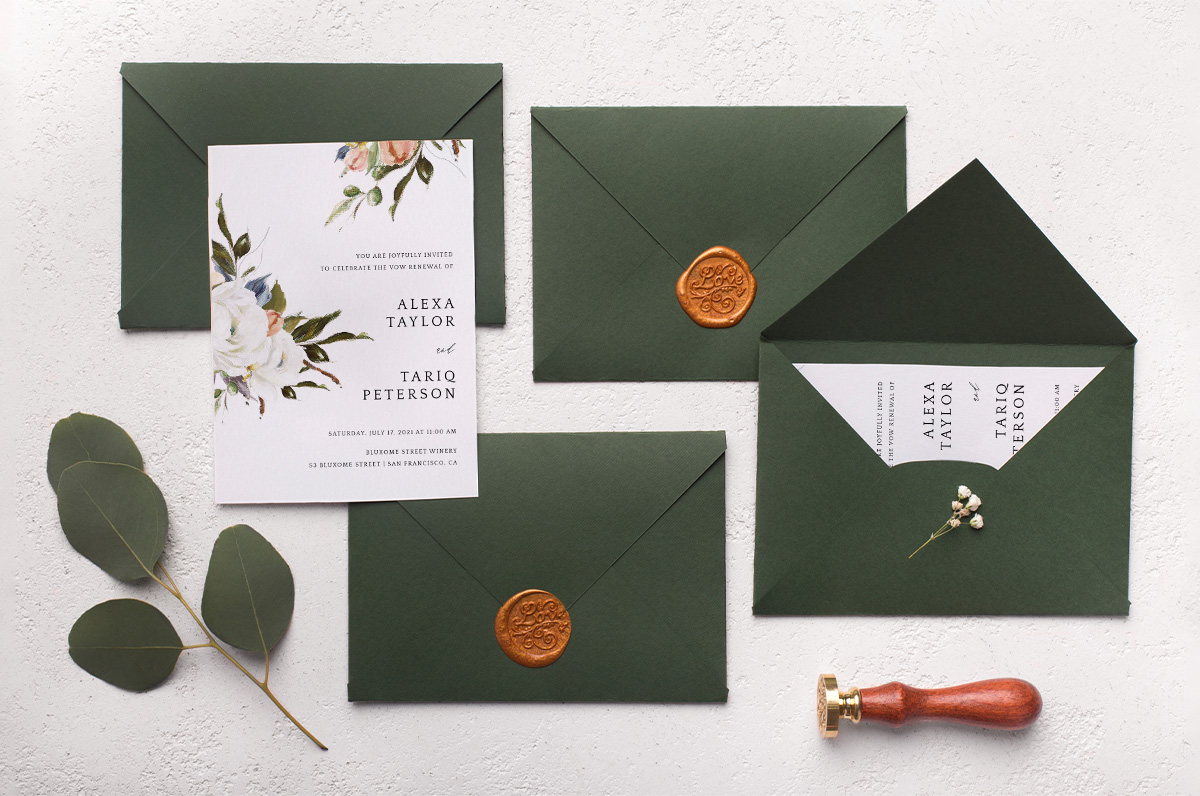
Guide to Wedding Invitation Wording
How-To
Your invitations set a first impression. In this guide, our experts lay out everything you need to know about wedding invitation wording and etiquette.

When To Send Save The Dates
Advice
Timing is key! Generally, save the dates should be sent no earlier than 8 months and no later than 4 months out from your wedding. Learn the specifics and more in this article.
Featured
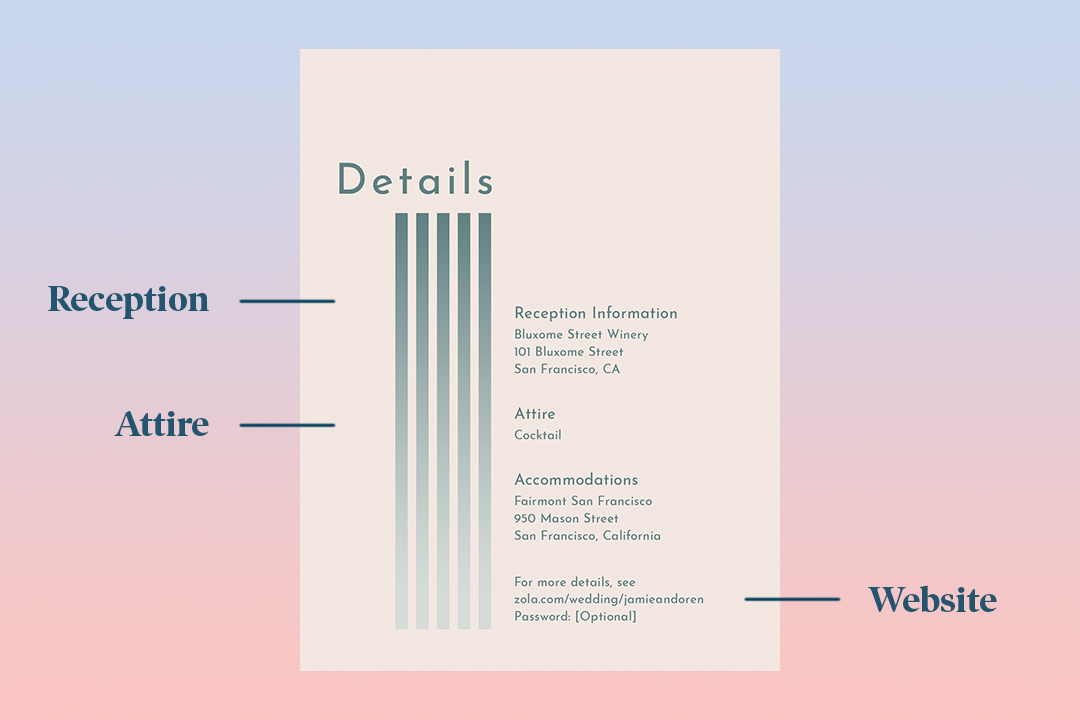
A Guide to Enclosure Cards
How To
Starting to create enclosure cards for your wedding? Follow along as we break down everything you need to know.
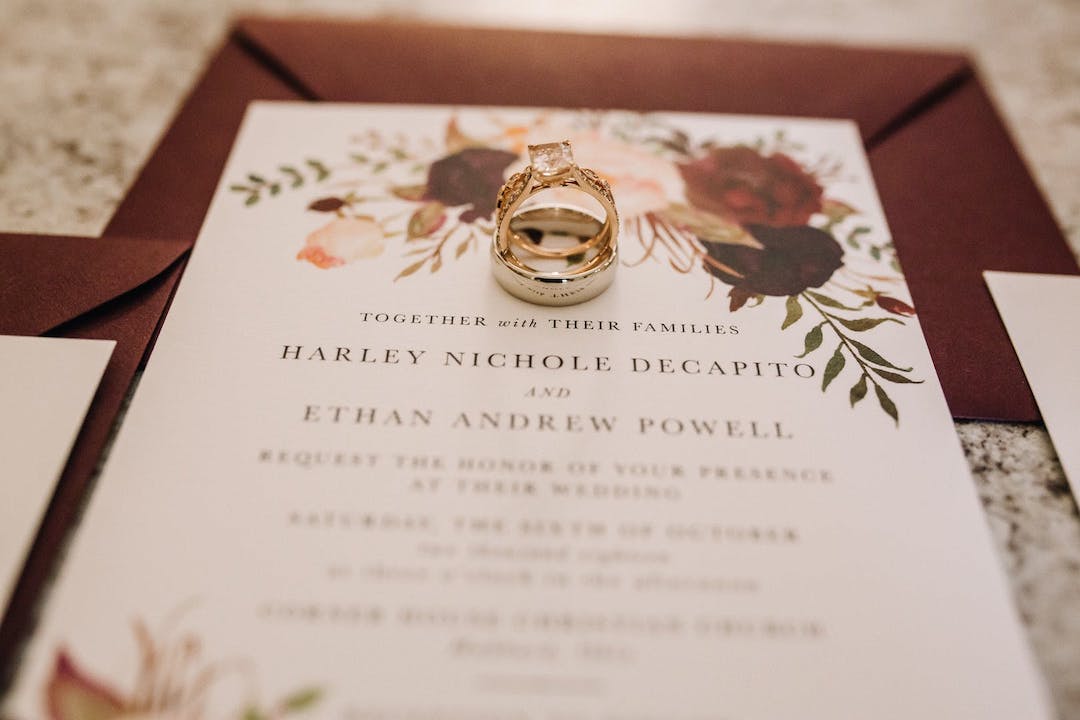
12 Rustic Wedding Invitations Ideas to Inspire You
Inspiration
Rustic weddings make the natural feel new again. Whether you’re opting for hand-drawn florals or festival prints, here are some ideas for rustic wedding invitations.
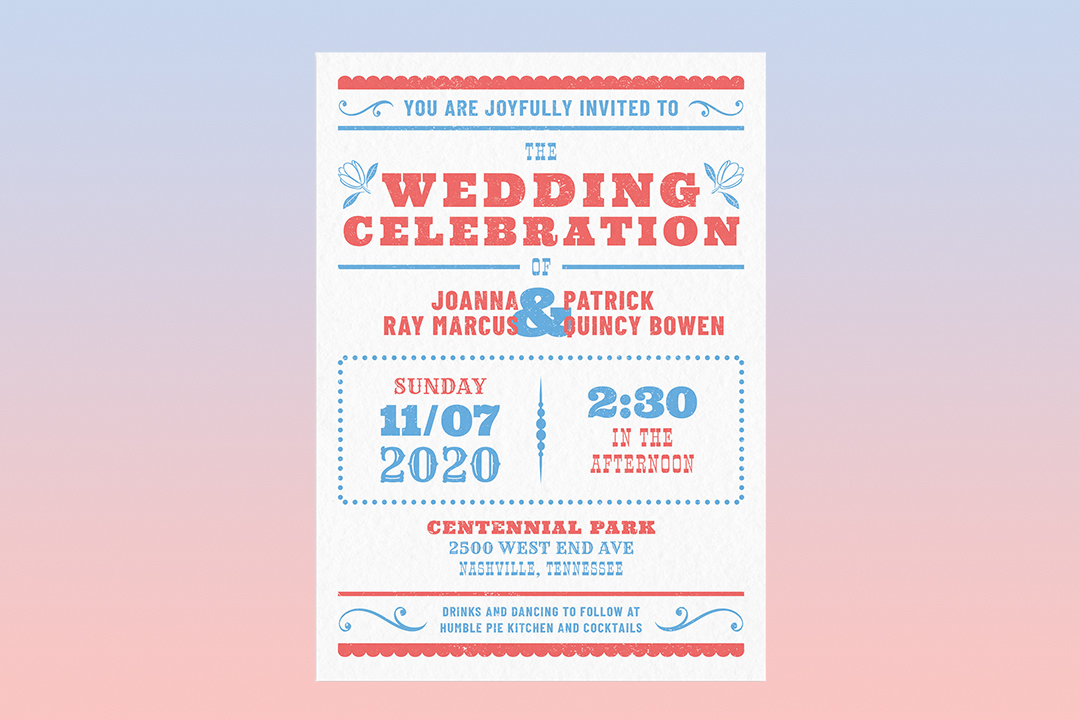
21 Unique Wedding Invitation Ideas
List
We have scoured the web for the most unique wedding invitations on the stationery scene, and we’re sharing them here.
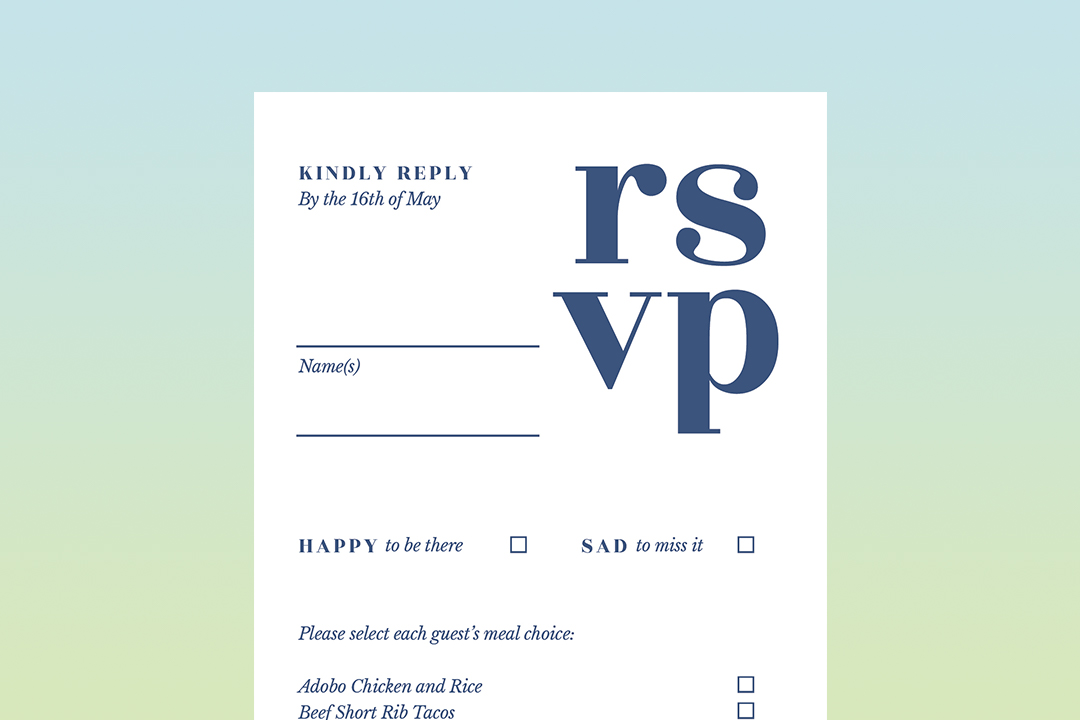
An Expert Guide to Wedding RSVP Cards & Complete Stationery Packages
Inspiration
Master wedding RSVP etiquette and discover complete wedding stationery packages with perfectly coordinated RSVP cards, free addressing, quality paper, and matching designs.
- Expert advice/
- Invites & paper/
- Invitations/
- What Information Should Be Included on Wedding Invitations & Invitation Suites?
Find even more wedding ideas, inspo, tips, and tricks
We’ve got wedding planning advice on everything from save the dates to wedding cakes.
